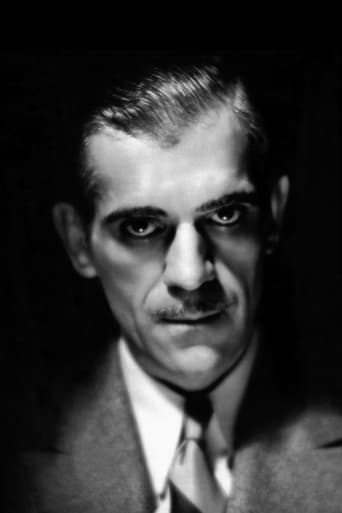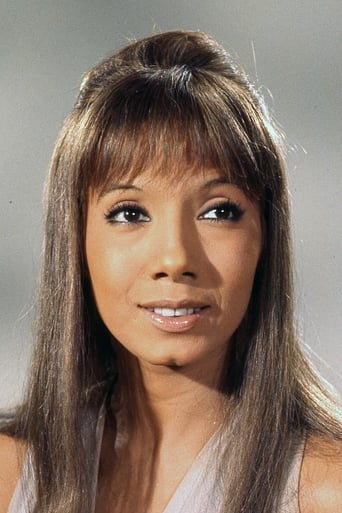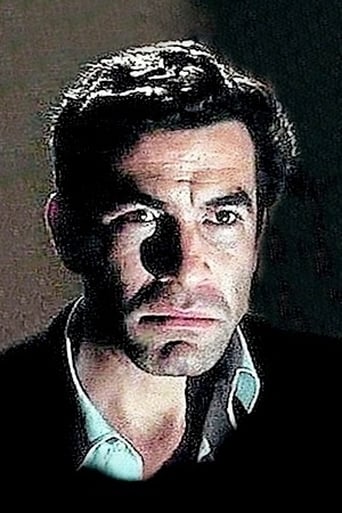BootDigest
Such a frustrating disappointment
MamaGravity
good back-story, and good acting
Dynamixor
The performances transcend the film's tropes, grounding it in characters that feel more complete than this subgenre often produces.
Livestonth
I am only giving this movie a 1 for the great cast, though I can't imagine what any of them were thinking. This movie was horrible
Edgar Soberon Torchia
A bad movie and a mediocre one coexist under the same title: first, a bland story of a horny French journalist turned tourist promoter, courting a blank Spanish girl, who falls prey of a sadistic bitch; and second, a horror tale involving a blind sculptor and his crazy wife, who kills animals and people with her lover's assistance to provide real bone structures for her husband's 3-D evocations of famous paintings. Characters go back and forth from A to B for 97 endless minutes. Pity is that both Lindfords and Karloff try hard to make any sense of the whole affair. Not a bad idea, but poorly executed, with dreadful music and silly special effects and nightmares. Be warned.
Steve Nyland (Squonkamatic)
CAULDRON OF BLOOD is, with all it's admitted faults, in reality a very important minor entry in the early stages of the Euro Horror boom years of 1967 to 1975 or so. The film's main draw is Boris Karloff, brought in to play an aged, blind, semi-invalid artist who is unwittingly using the bones of murder victims to create his world famous sculptural works.The reason why this is important is that Karloff's presence has lent the film a certain populist appeal that has nothing to do with the nature of the production, and indeed his performance is not only the best thing about the movie, but one of his most effective from what was sadly the twilight period of his career. Point being that thanks in part to repeated screenings on local Creature Feature Monster Movie Matinée slots during the 1970s (and of course as a home video rental era staple), a lot of people who might not otherwise be drawn to regional Euro Horror have managed to see it ... even though as most of the comments here reveal, many may have wished that they hadn't.But the point is still valid: Mention "That movie where Boris Karloff plays the blind guy with goggles and cane who fights over the acid vat" and most fans of grade C minus horror from the 1960s/1970s will know what you are referring to. And of course for Boris Karloff fans it's a must see effort, even though it managed to languish for 3 years between it's filming in 1967 and eventual release in 1970, by which time Karloff had passed away. Further research reveals that the role of the blind sculptor was originally intended for Claude Rains who himself inconveniently kicked the bucket during pre-production, and Karloff was brought in as a replacement. And when you think about it, his casting is somewhat reminiscent of a Spaghetti Western approach, with an A list star of some caliber being brought in to a European genre film to provide that box office kick -- and in this case it worked out like gangbusters, even if the end result is a bit esoteric for many.The film is essentially a pre-Giallo murder mystery with the requisite overcoat wearing gloved killer, red herrings, spooky overtones of psycho-sexual deviancy, kitschy fashion & pop culture references, offbeat local Spanish colorings, and a parade of supporting players who would later go on to play prominent roles in the Euro Horror cycle: Manuel de Blas, Rubén Rojo, Al Pereira, Milo Quesada, an over the top Viveca Lindfors as a sex crazed bisexual S&M freak, and most importantly Euro Sex Kitten Dyanik Zurakowska, who serves as a perversely unwitting muse to the blind artist's master work. The only member of the cast who genuinely seems out of place is the absurd jet-setting photojournalist/playboy romantic lead embodied by noted French ham actor Jean-Pierre Aumont, who apparently thought he had been cast in the movie's Maurice Chevalier role. The best thing that can be said of his work is that at least he wasn't given a chance to sing.Shot on an appallingly low budget, oddly paced, seemingly edited by someone on Quaaludes and consisting of a dozen or so loose ends that don't seem to match up, the film doesn't have much in the way of traditional horrors (or story structure) to recommend it, beyond some wonderful Euro horror ambiance and of course the presence of Karloff. Devotees of his classic era work may be saddened to see him reduced to playing a blind old man, but without necessarily intending to the movie emphasizes that by 1967 Karloff was getting old and frail and sick. Is it wrong for a film to reflect that which is true about the people who participate? Boris Karloff lived to make movies, appears to have approached the role with a certain amount of zeal and holds his own quite well, given the circumstances. Other "big names" like Joseph Cotton, James Philbrook and Guy Madison all had their twilight era Euro genre periods, and it's high time that the snobbish Americanized manner of looking down at such work was done away with. These aren't that bad compared to 90% of the horse hockey playing at your local multiplex this weekend.My attachment to the film is purely nostalgic: I vividly remember the movie scaring the wits out of me as a young chap sneaking in a monster movie instead of doing chores on a Saturday afternoon, and being confused by the Filmation stock music used to flavor the score that I was familiar with from shows like SHAZAM! and the animated "Star Trek" cartoon series from the early 1970s. But I admit it's a wretched movie, with about forty minutes of pretty decent Euro horror broken up by another hour of dreck that most contemporary viewers will have very little use for. Nonetheless it's historically important, actually gets better with multiple viewings as you work out the seemingly disjointed parts, has some great decrepit atmosphere in certain sections, and in the middle an overlooked Boris Karloff role that is better than the movie's detractors -- including his fans -- may lead one to believe.5/10: By the way, all known versions currently in existence for home video are censored, though those edits may have been pre-release chops done by Franco era Spanish authorities, in which case it's probably an irretrievable loss. Further proof that totalitarianism does indeed suck rather hard.
BaronBl00d
I guess I am the odd man out here. I rather thought this film - a troubled production that took years to complete and finally hit the screen - was rather entertaining in a sick, undeniably twisted, bad way. Yes, it has some lamentable aspects. Karloff is ancient and it shows. The story has lots of continuity problems(remember it was completed over several years and was not released till a couple years after Karloff's death). It has a very perverse story line about Karloff, a great artist living in Spain, and his demented, tormenting wife, played with zeal by Viveca Lindfors, needing bodies for his sculptures. You see, even though he is blind, he still can sculpt based on armatures based on real remains. Karloff believes his wife is getting them one way, and she is definitely getting them another way. French photographer Jean Pierre Aumont smugs for the camera saying silently, "God, don't I look so charming." He isn't, but he is an adequate leading man if nothing else. The girls in the story, particularly the girl playing Elga and Rosenda Monteros as Valerie are lovely creatures at the very least. And what about Karloff? He is still good and still one of the best things about this film(though my greater inclination is to side with one of the nastiest female portrayals in film I've seen in some time by Ms. Lindfors). Karloff still has a commanding voice and presence, and this film role is much meatier than any of that garbage he did for Mexico at the very end of his life. This movie has much greater continuity and story line than any of those four horror stories of film. Cauldron of Blood is by no means a great film - nor a good film, but I did find it reasonably entertaining and I, for one, was never bored watching it. Really, how can you go wrong with King Karloff, Viveca Lindfors wearing a Nazi-like uniform with riding crop and nylon netting under her eyes having flashbacks of her youth as a pig-tailed blonde no less, a cauldron of acid that burns the flesh off of any carcass, and a fight scene in the dark with a blind man and his hateful wife. As Karloff's character says to his wife, having just accused her of causing him to be blind, "Till death do we part I suppose." Nobody ever said a line like Boris!
whpratt1
Producer Robert D Weinbach originally wanted Claude Rains for the role of Badulescu, but due to Rains's illness, he was replaced by Karloff. Originally titled Blind Man's Bluff, the film was shot in and around Madrid. Filming began in Februrary 1967 and lasted almost three months. Karloff was in ill health himself, but never wanted to give up acting and worked in his craft until he died in 1968. Karloff worked hard as a laborer and even a truck driver between acting roles when he was first starting out in Canada and knew what it was to miss a few meals. Karloff made this film a classic and it will be viewed and talked about from generation to generation whether we like it or NOT!





